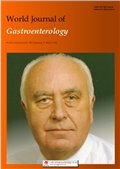- 钛学术文献服务平台 \
- 学术期刊 \
- 医药卫生期刊 \
- 内科学期刊 \
- 世界胃肠病学杂志(英文版)期刊 \
Exertional esophageal pH-metry and manometry in recurrent chest pain
Exertional esophageal pH-metry and manometry in recurrent chest pain
基本信息来源于合作网站,原文需代理用户跳转至来源网站获取
摘要:
AIM: To investigate the diagnostic efficacy of 24-h and exertional esophageal pH-metry and manometry in patients with recurrent chest pain. METHODS: The study included 111 patients (54% male) with recurrent angina-like chest pain, non-respon- sive to therapy with proton pump inhibitors. Sixty-five (59%) had non-obstructive lesions in coronary artery angiography, and in 46 (41%) significant coronary artery narrowing was found. In all patients, 24-h esophageal pH-metry and manometry, and treadmill stress tests with simultaneous esophageal pH-metry and manometry monitoring were performed. During a 24-h examination the percentage of spontaneous chest pain (sCP) episodes associated with acid reflux or dysmotility (symptom index, SI) was calculated. Patients with SI > 50% for acid gastroesophageal reflux (GER) were classified as having GER-related sCP. The remaining symptomatic individuals were determined as having non-GER-related sCP. During the stress test, the occurrence of chest pain, episodes of esophageal acidification (pH < 4 for 10 s) and esophageal spasm with more than 55% of simultaneous contractions (exercise-provoked esophageal spasm or EPES) were noted. RESULTS: Sixty-eight (61%) individuals reported sCP during 24-h esophageal function monitoring. Eleven of these (16%) were classified as having GER-related sCP and 53/68 (84%) as having non-GER-related sCP. The exercise-provoked chest pain during a stress test occurred in 13/111 (12%) subjects. In order to compare the clinical usefulness of 24-h esophageal function monitoring and its examination limited only to the treadmill stress test, the standard parameters of diagnostic test evaluation were determined. The occurrence of GER- related or non-GER-related sCP was assumed as a "gold standard". Afterwards, accuracy, sensitivity and specificity were calculated. These parameters expressed a prediction of GER-related or non-GER-related sCP occurrence by the presence of chest pain, esophageal acidification and EPES. Accuracy, sensitivity and specificity of chest pain during the stress test predicting any sCP occurrence were 28%, 35% and 80%, respectively, predicting GER- related sCP were 42%, 0% and 83%, respectively, and predicting non-GER-related sCP were 57%, 36% and 83%, respectively. Similar values were obtained for exercise-related acidification with pH < 4 longer than 10 s in the prediction of GER-related sCP (44%, 36% and 92%, respectively) and EPES in relation to non-GER-related sCP (48%, 23% and 84%, respectively). CONCLUSION: The presence of chest pain, esophageal acidification and EPES had greater than 80% specificity to exclude the GER-related and non-GER-related causes of recurrent chest pain.

推荐文章
贲门失弛缓症患者食管上下括约肌压力变化与年龄的关系
贲门失弛缓症
食管上括约肌
食管下括约肌
高分辨率食管测压
上食管括约肌异常与食管动力障碍疾病的相关性
上食管括约肌
食管动力障碍
高分辨率食管测压
急性食管源性胸痛42例误诊为冠心病分析
急性食管源性胸痛
误诊
冠心病
心绞痛
高分辨率食管测压检测坐位和卧位对14例健康国人食管动力的影响
高分辨率食管测压
食管动力
食管括约肌
内容分析
关键词云
关键词热度
相关文献总数
(/次)
(/年)
文献信息
| 篇名 | Exertional esophageal pH-metry and manometry in recurrent chest pain | ||
| 来源期刊 | 世界胃肠病学杂志(英文版) | 学科 | 医学 |
| 关键词 | |||
| 年,卷(期) | 2010,(34) | 所属期刊栏目 | |
| 研究方向 | 页码范围 | 4305-4312 | |
| 页数 | 8页 | 分类号 | R541|R571 |
| 字数 | 语种 | 中文 | |
| DOI | |||
五维指标
引文网络
引文网络
二级参考文献 (0)
共引文献 (0)
参考文献 (14)
节点文献
引证文献 (0)
同被引文献 (0)
二级引证文献 (0)
1990(1)
- 参考文献(1)
- 二级参考文献(0)
1998(3)
- 参考文献(3)
- 二级参考文献(0)
2002(1)
- 参考文献(1)
- 二级参考文献(0)
2006(2)
- 参考文献(2)
- 二级参考文献(0)
2007(2)
- 参考文献(2)
- 二级参考文献(0)
2008(4)
- 参考文献(4)
- 二级参考文献(0)
2009(1)
- 参考文献(1)
- 二级参考文献(0)
2010(0)
- 参考文献(0)
- 二级参考文献(0)
- 引证文献(0)
- 二级引证文献(0)
引文网络交叉学科
相关学者/机构
期刊影响力
世界胃肠病学杂志(英文版)
主办单位:
太原消化病研治中心
出版周期:
周刊
ISSN:
1007-9327
CN:
14-1219/R
开本:
大16开
出版地:
北京市朝阳区东四环中路62号楼远洋国际中心D座903室
邮发代号:
22-138
创刊时间:
1995
语种:
eng
出版文献量(篇)
11717
总下载数(次)
2
总被引数(次)
153176
期刊文献
相关文献
推荐文献
- 期刊分类
- 期刊(年)
- 期刊(期)
- 期刊推荐
世界胃肠病学杂志(英文版)2012
世界胃肠病学杂志(英文版)2011
世界胃肠病学杂志(英文版)2010
世界胃肠病学杂志(英文版)2009
世界胃肠病学杂志(英文版)2008
世界胃肠病学杂志(英文版)2007
世界胃肠病学杂志(英文版)2006
世界胃肠病学杂志(英文版)2005
世界胃肠病学杂志(英文版)2004
世界胃肠病学杂志(英文版)2003
世界胃肠病学杂志(英文版)2002
世界胃肠病学杂志(英文版)2001
世界胃肠病学杂志(英文版)2000
世界胃肠病学杂志(英文版)1999
世界胃肠病学杂志(英文版)1998
世界胃肠病学杂志(英文版)2010年第9期
世界胃肠病学杂志(英文版)2010年第8期
世界胃肠病学杂志(英文版)2010年第7期
世界胃肠病学杂志(英文版)2010年第6期
世界胃肠病学杂志(英文版)2010年第5期
世界胃肠病学杂志(英文版)2010年第47期
世界胃肠病学杂志(英文版)2010年第44期
世界胃肠病学杂志(英文版)2010年第42期
世界胃肠病学杂志(英文版)2010年第41期
世界胃肠病学杂志(英文版)2010年第40期
世界胃肠病学杂志(英文版)2010年第4期
世界胃肠病学杂志(英文版)2010年第38期
世界胃肠病学杂志(英文版)2010年第37期
世界胃肠病学杂志(英文版)2010年第35期
世界胃肠病学杂志(英文版)2010年第34期
世界胃肠病学杂志(英文版)2010年第33期
世界胃肠病学杂志(英文版)2010年第32期
世界胃肠病学杂志(英文版)2010年第31期
世界胃肠病学杂志(英文版)2010年第3期
世界胃肠病学杂志(英文版)2010年第29期
世界胃肠病学杂志(英文版)2010年第28期
世界胃肠病学杂志(英文版)2010年第27期
世界胃肠病学杂志(英文版)2010年第26期
世界胃肠病学杂志(英文版)2010年第25期
世界胃肠病学杂志(英文版)2010年第24期
世界胃肠病学杂志(英文版)2010年第23期
世界胃肠病学杂志(英文版)2010年第22期
世界胃肠病学杂志(英文版)2010年第21期
世界胃肠病学杂志(英文版)2010年第20期
世界胃肠病学杂志(英文版)2010年第2期
世界胃肠病学杂志(英文版)2010年第19期
世界胃肠病学杂志(英文版)2010年第18期
世界胃肠病学杂志(英文版)2010年第17期
世界胃肠病学杂志(英文版)2010年第16期
世界胃肠病学杂志(英文版)2010年第15期
世界胃肠病学杂志(英文版)2010年第14期
世界胃肠病学杂志(英文版)2010年第13期
世界胃肠病学杂志(英文版)2010年第12期
世界胃肠病学杂志(英文版)2010年第11期
世界胃肠病学杂志(英文版)2010年第10期
世界胃肠病学杂志(英文版)2010年第1期

 免费查重
免费查重










